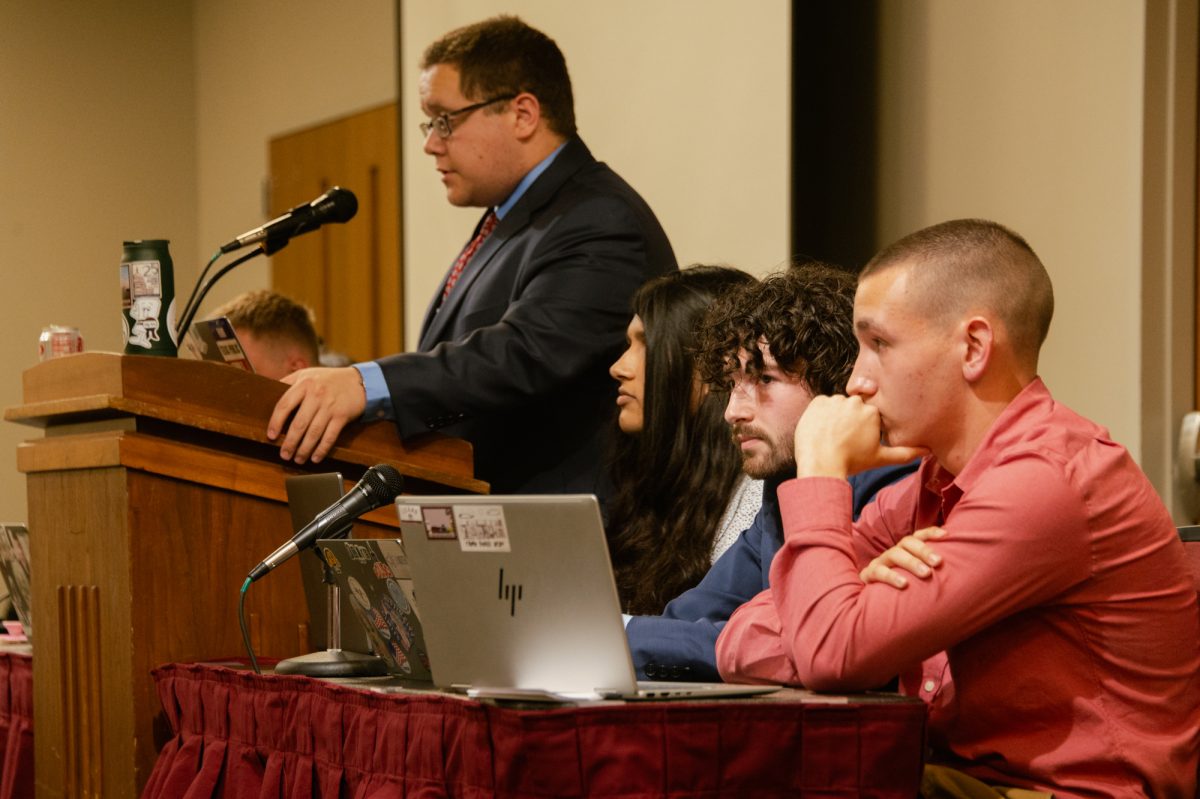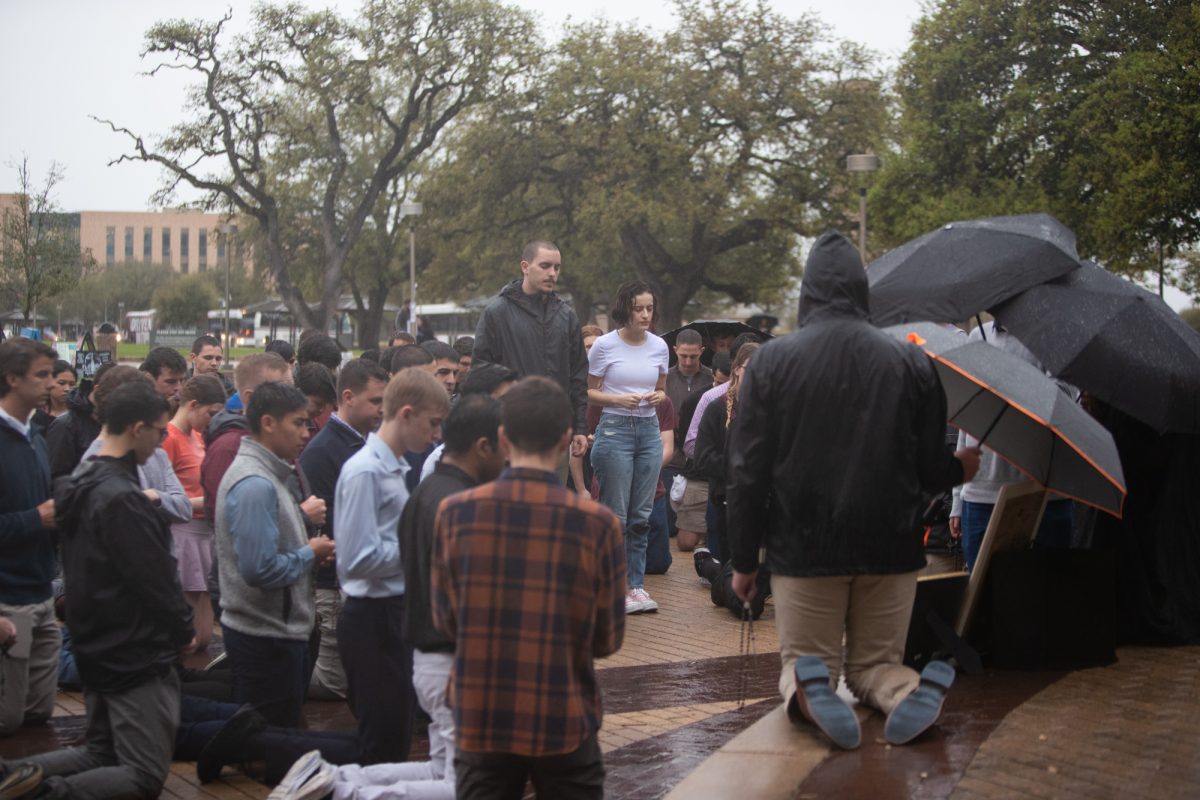Editor’s note: This story contains descriptions of sexual violence and harassment. Victims’ names were replaced with pseudonyms to protect their identities.
“Texas A&M University will promptly address all complaints of sex-based discrimination, harassment and related retaliation made by or against faculty, staff, students, guests and vendors,” the A&M Title IX website reads.
However, as reports of sexual violence increase, some students said they aren’t receiving the assistance they need. Three Aggie women said Title IX inaction and months-long delays led to alleged offenders receiving no consequences or disciplinary action.
A&M Title IX Coordinator Jennifer Smith said the office is understaffed and facing record complaints, and one former case manager said while the staff enjoyed working with students, they lacked the infrastructure to properly help victims.
Delays, delays, delays
“Abby,” a freshman in 2020, said she lived in the White Creek Apartments. She met a man on a dating app, and when he asked to come over, she said yes.
“We started to have sex, and I got really uncomfortable with it,” Abby said. “He was five years older than me, and I thought that I was going to be OK with that, but I wasn’t. When I started saying, ‘Hey, I’m not really comfortable with this,’ he told me I wasn’t allowed to say no. I tried a couple of times to kind of get away from that, but he physically restrained me … [he] was a foot and a half taller than me [and] had 75 pounds on me. It really was a bad situation.”
She said after he left, she was left bruised and her room was ruined. The tapestries and pictures on her wall had fallen off, and she didn’t know what to do, Abby said.
At the time, she said she didn’t realize it was sexual assault, as she had originally consented before she revoked it. First, she contacted RAINN, the Rape, Abuse and Incest National Network, who told her to contact the Title IX office at A&M.
Title IX is the result of a law prohibiting sexual discrimination in programs that receive federal funding — such as universities and student organizations. The office also handles sexual assault, harassment and discrimination cases on campus, with case managers assigned to each victim’s case.
Abby reached out to Title IX soon after her assault, but she said they weren’t available for months.
“It took three months to actually set up an appointment,” Abby said.
Abby said the man graduated that May, leaving Title IX’s jurisdiction altogether. By the time the meeting took place, Abby said she was only given two options: mediation and investigation.
Mediation would have the two sitting in a room, each with counsel, talking with each other to work things out, she said. An investigation would require a full testimony in front of a board of professors and students, which would then give a guilty or innocent verdict.
“Both options actually depended on him agreeing to those happening in the first place because he had graduated,” Abby said. “If he had said no to either of those things, that was just the end of the road.”Even if he agreed to an investigation and was found guilty, Abby said the only punishment would be a mark on his official transcript noting a Title IX violation.
She also said her case manager told her going to the police was an option but dissuaded her from doing so, saying it would be easier to get a guilty verdict from a Title IX investigation.
She told her case manager she needed time to think about her next steps. Her case manager reached out a few days later, but Abby said she still needed more time. Then, she said she never heard from Title IX again.
“He works at this tech startup now, making mid-six figures right out of college,” Abby said. “The worst [Title IX] could do was put an asterisk next to his name, and they didn’t even get to do that. So he gets to live his life, and I have to think about it all the time.”
Campus-wide issues
Earlier this year, a male student was allegedly caught taking pictures of a female student after sneaking into a bathroom stall.
“Sam,” an individual in the department who requested anonymity, said after the woman in the stall realized there was a student taking pictures of her, she left the restroom and called everyone in her lab to stand outside, waiting for the individual to come out.
“It was at this point that the cops would have been called, but the professor in the situation told [the victim] that they were going to just contact Title IX and have Title IX handle it,” Sam said.
Sam said the male student then came out of the bathroom and was confronted by the other students before the professor separated them all. Sam said the incident occurred on a Friday and was reported on Monday.
Immediately after hearing about the situation, Sam said other staff and faculty in the department reported it to the university police.
“The staff … once they heard this and called the police as well, Title IX was like, ‘Why would you do that? We were handling this,’” Sam said.
Sam said university employees were then threatened with disciplinary action for reporting the situation to the university police rather than Title IX itself, as university employees are considered mandatory reporters and must report sexual assault, harassment, dating violence and stalking to the Title IX coordinator, according to state law.
Sam said the Title IX office took over the case, and after a brief investigation, declared the alleged offender innocent. Because the office is understaffed and has limited investigative power, an innocent verdict is a common ending to these incidents, they said.
A&M Title IX statistics show there were 527 reports in the 2019–20 academic year and 492 in the 2020–21 academic year. That number rose to 1,019 reports in the 2021–22 year.
Each year included reports of alleged violations of gender equality, including sexual assault or harassment, from university employees and students at A&M. In the 2021–22 academic year, 221 reports were classified as duplicate reports and 33 were confidential reports, which are not eligible for investigation.
Of the remaining 765 reports, 343 were closed by the complainant, 20 were closed due to lack of jurisdiction and 185 were closed due to lack of information, leaving 217.
The statistics show only 25 investigations were conducted in the academic year, with 176 cases still pending. The rest, 16, were resolved through an informal resolution agreement, such as mediation. Of the initial 1,019 Title IX reports in the 2021-22 academic year, only 2.4% resulted in an investigation.
Of the 25 investigations, two ended with no policy violation found, one concluded with an employee disciplinary sanction, five ended with a student disciplinarily sanctioned, two ended with an informal resolution and 15 were pending a disciplinary process at the time of release.
A failed notice, a failed no-contact order
“Bella’s” freshman year happened during the COVID-19 pandemic, and she said it was hard to make friends during that time. Eventually, she met a guy, and they hung out at his house to watch movies one time, she said. It went well, but days later, Bella said he became insistent about having sex. She said she went to his house soon after to hang out.
“He kept asking to have sex over and over and over again,” Bella said. “ … He’s just really, really pushy, and I was like, ‘I don’t want to be here anymore. I want to leave.’”
But Bella said there wasn’t any way for her to get home, as it was night and he drove her. So, with no other options, she said she reluctantly agreed.
“Then, immediately … the term he used [was] ‘the hymen broke,’ and I started bleeding everywhere,” Bella said. “So I guess I kind of got saved, I guess. … I was standing in the [apartment] shower, just bleeding. And I was like, ‘I want to go home.’”
She said he got mad at her afterward.
“I thought we were friends,” Bella said. “I didn’t want to do that, and I did it. I just felt kind of gross about myself.”
He dropped her off, and when she got home, Bella said he started telling her it was just a mishap, that it wouldn’t happen again and it’s not as bad as it seems. He told her it wasn’t his intention, Bella said. She said they still talked every day, with him apologizing throughout. Eventually, she said they met again weeks later at her apartment.
“I guess I was really naive because I thought that he wouldn’t want that again,” Bella said.
Bella said she wanted to watch a movie, but he was insistent about having sex. Bella said with no way to get rid of him, she said yes.
“At one point, I was crying,” Bella said. “I was crying, and I was trying to move. I was trying to get away.”
Bella said he began physically restraining her, and he only left after she got a call from her neighbor. It was at that point Bella said she knew she had to report him.
She said she met with a Title IX case manager, where she was given three options: mediation, investigation and a meeting between Title IX and the perpetrator about consent. Bella said she was told the investigation could take more than a semester, so she chose the meeting about consent instead. She said she also decided to have a no-contact order put in place, meaning Title IX could take disciplinary action if he contacts her.
Bella said she reported him in late June, but the notification informing the man he had a Title IX complaint was sent months later — right before the fall semester final exams. While she waited during the semester, she said she saw him multiple times.
“I was so afraid,” Bella said. “I just felt like a shell of a person.”
But once the Title IX notice was sent, Bella said she realized they forgot to send the notice of no contact.
“So, immediately, he starts, like, as soon as [the Title IX notification was] sent out [to him], he starts trying to contact me,” Bella said. “And he immediately tried to call me on Instagram and added me on Snapchat.”
Bella said she had to call her case manager 15 times before they answered, and they had to expedite a notice of no contact.
Bella said she was also informed Title IX can check if victims have classes with the offender, so she emailed her case manager to check for the following spring semester. However, she said her case manager didn’t respond for three months.
As for the meeting about consent, Bella said she never knew if it happened.
“[My case manager said] he never responded [to Title IX],” Bella said. “And I’m like, ‘He never responded? What’s happening? Are you all gonna make him respond? Is something going to happen?”
Difficulties facing the office
In an Oct. 16 email, Title IX Coordinator Jennifer Smith said the Title IX office, alongside the Office of Civil Rights and Equity Investigations, or CREI, that oversees it, has been understaffed because of an “increase in regulatory requirements, a hiring freeze under the previous administration, high staff turnover and a record number of complaints.”
“During the last academic year, CREI responded to 2,794 complaints,” Smith said in the email. “At one point last summer, we were down to two case managers.”
However, Smith said the office recently received authorization to double the number of case managers. She said the office has been busy recruiting this fall, with the last hire scheduled to start in November.
“At that time, we will have six case managers plus a deputy Title IX coordinator for case management,” Smith said. “This is an appropriate level of staffing for our current workload.”
“Rey,” a former case manager, requested anonymity due to a fear of retaliation. Rey said the lack of staff made the job difficult.
“I really think the folks I worked with have good intentions,” Rey said. “They want to help people. That’s why they’re there.”
They said the cases were split among the available case managers — even if it was hundreds of cases per staffer.
“I think [Smith] does the best she can with the infrastructure she is provided,” Rey said. “ … with that being said, she’s also one person, right? … When you have a student body the size of the university that A&M has, not just in College Station, but across the state and abroad — it’s hard to be everywhere at once.”
Rey said if there’s anything they could’ve changed while they were there, it would be improving the flow of cases and how they’re managed so “the folks on the ground could actually focus on putting that support together for the community.”
“Having such a large population of folk and not having adequate funding, having fully-trained people on staff all the time [and] having high turnover is a problem,” Rey said. “ … I think everyone’s just doing the best they can.”










